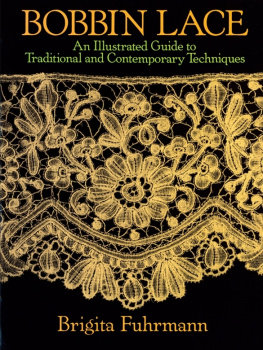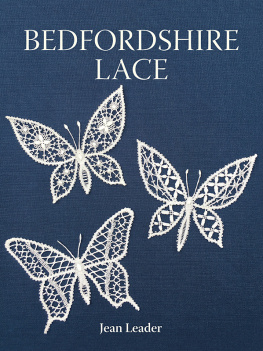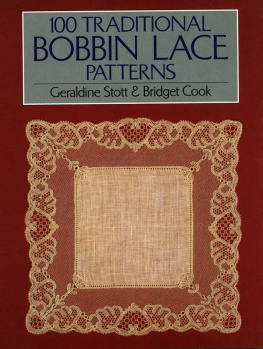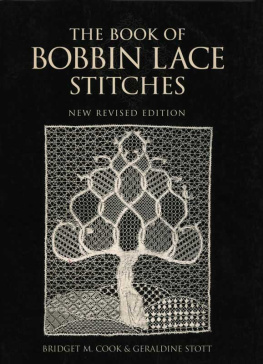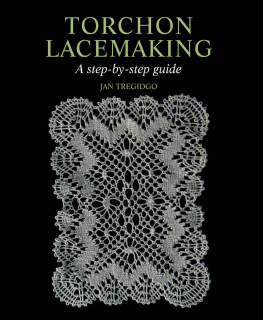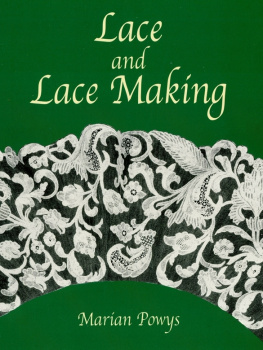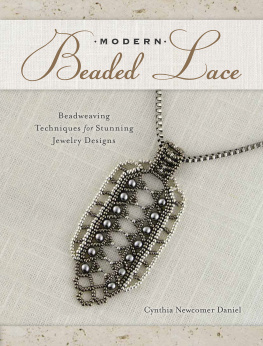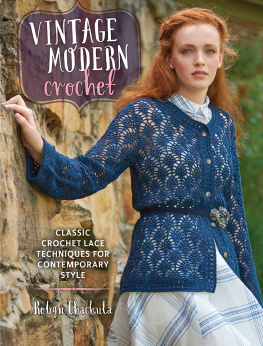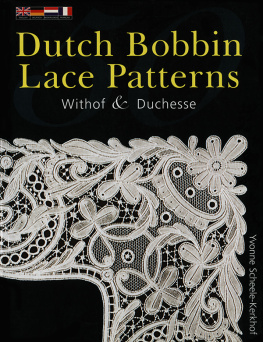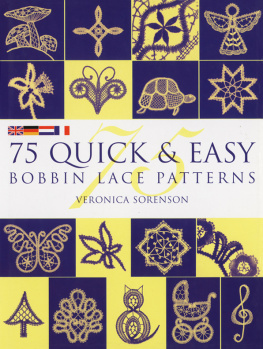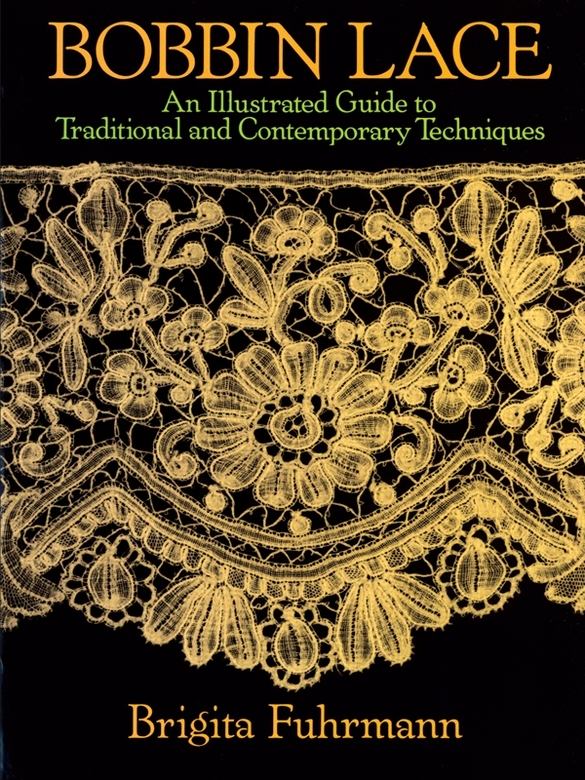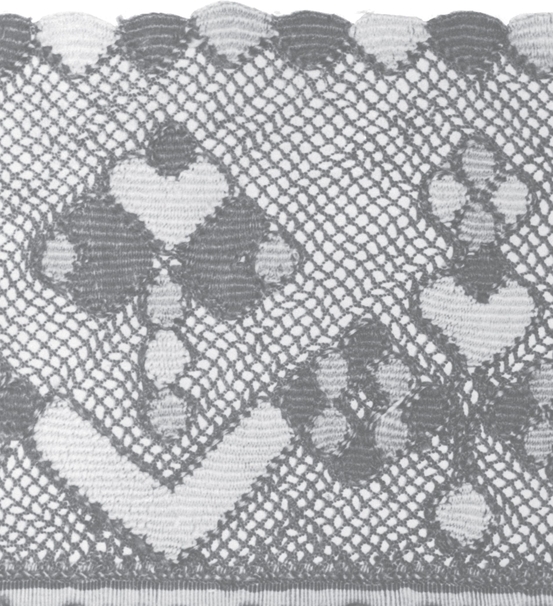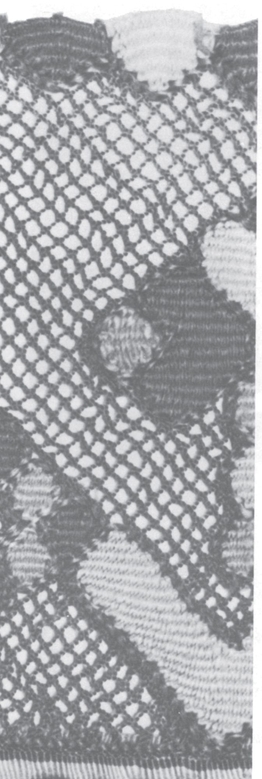During the past several years while conducting workshops and classes in lacemaking, I have met a large number of dedicated and enthusiastic people who have shown a sincere interest in learning this art. It is because of their interest and expressed need for a manual of peasant lacemaking that I undertook the writing of this book, which would not have been possible without the help of some very wonderful people whom I should like to thank here.
In this type of book the photographs are as important as the text, and I consider myself fortunate to have found a professional photographer of the caliber of Howard J. Levitz. It was also my good fortune to have editors as cooperative and helpful as Jennifer Place and Ellen Zeifer.
I am deeply indebted to the following museum personnel for their prompt and helpful assistance: Jo Bidner, Volunteer, Costume and Textile Department, Brooklyn Museum; Elizabeth Ann Coleman, Curator, Costume and Textile Department, Brooklyn Museum; A. Nahlik, Head, Polish Textile History Museum; V. A. Pushkarev, Director, Leningrad Museum; Larry Salmon, Curator, Textile Department, Boston Museum of Fine Arts; Milton Sondy, Curator, Textile Department, Cooper-Hewitt Museum; Dr. Maria Taszycka, Curator of Textiles, National Museum in Cracow, Poland; and Barbara Teague, Textile Department, Metropolitan Museum of Art.
The following people offered much more than was asked of them, and I found them not only helpful but encouraging: Mary Ann Beinecke, President, Hoo-suck Community Resources Corporation; Gertrude Biederman, teacher of lacemaking and author; David Manzella, Head, Graduate School, Rhode Island School of Design; Dr. Ema Markova, Czechoslovakian Textile Authority; and Esther Oldham, collector of fans and laces.
I also wish to thank the following lacemakers who were generous enough to send more work than I could include in this book: Emilie Frydecka, Elena Holeczy, Kaethe Kliot, Suzanne Lewis, Mary Lou Reichard, Jarmila Sikytova, Cindy Van Dine, Lydia Van Gelder, and Marie Vankova.
I am especially indebted to my parents, Josef and Marie Holler, to Alice Marcoux, Ruth Ginsberg-Place, and James Russell for the encouragement and support they gave me during the initial phases of this book. And to my husband, Bill, without whom this book might never have reached completion, I wish to express my most sincere appreciation.
BIBLIOGRAPHY
Bamateanu, T., Fosca, G., and Ionescu, E. Folk Costumes of Rumania. Rumania: State Publishing House for Literature and the Arts, c. 1958
Bath, Virginia Churchill. Lace. Chicago: Regnery, c. 1974
. Barbours Prize Needlework Series, Nos. 3 and 4. Barbour Brothers Company, c. 1895
Bossert, H. Peasant Art in Europe. Berlin: Ernst Wasmuth, c. 1926
Butnik-Siberskiy, B. Ukrainske Narodne Mistetsvo. Kiev: Mistetsvo, c. 1967
Caufield, S. F. A., and Seward, Blanche C. Dictionary of Needlework. London: W. Cowan
Channer, C. C. Lacemaking, Point Ground. Leicester: The Dryard Press, c. 1970
Czarnecka, Irena. Polnische Volkskunst. Poland: Warsava, c. 1957
Davydova, S. Russkoe Kruzevo and Russkie Kruzevnicy, Vols. 1 and 2. St. Petersburg, c. 1892
de Dillmont, Therese. Encyclopedia of Needlework, Mulhouse, France: D.M.C. Library
Editors of American Fabrics Magazine. Encyclopedia of Textiles. New Jersey: Prentice Hall, c. 1960
Emery, Irene. The Primary Structures of Fabrics. Washington, D. C.: Textile Museum, c. 1966
Fel, E., Hofer, T., and Csillery, K. Hungarian Peasant Art. Budapest: Corvina, c. 1958
Gorbunoff, M. Uber Russische Spitzenindustries. Vienna, c. 1886
Grom, Bogdan. Slovene Ornaments. Trieste: Folcloristic Collection, c. 1949
Gubser, Elsie H. Bobbin Lace. Oregon: Robin and Russ Hand-weavers, c. 1975
Gyula, Ortutay. A Magyar Nepmuveszet. Kiadasa: Franklin-Tarsulat, c. 1941
Jackson, Emily F. A History of Handmade Lace. New York: Charles Scribners Sons, c. 1900
Kaminska, Janina, and Turnau, Irene. Zarys Historii Wlokiennictva Na Zemiach Polskich. Wroclaw, c. 1966
Kovacevicova, Sona. Lidove Vytvarne Umeni. Czechoslovakia: Statni Pedagogicke Nakladatelstvi, c. 1974
Kybalova, Ludmila. Emilie Palickova Bibliography. Czechoslovakia: Nakladatelstvi Ces-koslovenskzch Vytvarnych Umelcu, c. 1962
Loukomski, G. K. Le Kreml De Moscou. Paris: Editions Milsson, c. 1927
Lowes, Emily Leigh. Chats on Old Lace and Needlework. London: T. Fisher Unwin, c. 1908
Maidment, Margaret. Manual of Handmade Bobbin Lacework. Chicheley, England: Paul P. B. Minet, c. 1971
Makovski, S. Peasant Art of Subcarpathian Russia, Czechoslovakia: Plamja, c. 1926
Markova, Ema. Slovenske Cipky. Bratislava, Czechoslovakia: Slovenske Vydavatelstvo Krasnej Literatury, c. 1962
Mayer, Christa. Three Centuries of Bobbin Lace. Antiques Magazine, August, 1966
Mincoff, Elizabeth, and Marriage, Margaret S. Pillow LaceA Practical Handbook. Chicheley, England: Paul P.B. Minet, c. 1971
Oprescu, George. Peasant Art in Roumania. Special 1929 Autumn issue of Creative Art. New York: Albert and Charles Boni
Palliser, Mrs. Bury. A History of Lace. London: Low and Searle, c. 1875
Patkova, Jarmila. Ludocy Odev V Okoli Trnavy. Bratislava, Czechoslovakia: Slovenske Vydavatelstvo Krasnej Literatury, c. 1957
Pietkewicz, Kazimier. Haft I Zdobenie Stroju Ludovego. Warszawa: Sztuka, c. 1955
Pond, Gabrielle. An Introduction to Lace. New York: Charles Scribners Sons, c. 1973
Rabotova, I. P. Russkoe Narodnoe Kruzevo. Moscow, USSR: Vsesouznoe Koopera-tivnoe Izdashcelstvo, c. 1956
Schuette, Marie. Alte Spitzen. Richard Carl Schmidt and Co., c. 1914
Sharp, Mary. Point and Pillow Lace. New York: E. P. Dutton and Co., c. 1913
Slassoff, W. LOrnament National Russe. St. Petersburg, c. 1872
Stech, V. V., and Vydrova, J. Kouzlo Bilych Niti. Hradec Kra-love, Czechoslovakia: Krajska Gallerie, c. 1965
Tebbs, Lousia A. The Art of Bobbin Lace. Chicheley, England: Paul P. B. Minet, c. 1972
Vaclavik, Antonin, and Orel, Jaroslav. Texile Folk Art. Czechoslovakia: Artia Praha, c. 1956
Von Henneberg, Freiherr Alfred. The Art and Craft of Old Lace. New York: E. Weyhe, c. 1931
Whiting, Gertrude. Old Time Tools and Toys of Needlework. New York: Dover Publication, c. 1971
. A Lace Guide for Makers and Collectors. New York: E. P. Dutton and Co., c. 1920
HISTORY
A Slovakian lacemaker from Turie Pole at work on her cylindrical pillow. Photo Jozef Vydra.
The development of the technique of bobbin lace is not well recorded, and a lot of the available information is founded on probability. The oldest specimens of lace have very rarely survived, and written descriptions are not always completely reliable. The first dependable recording of lace began with portrait painting, where details of clothing were accurately represented.
Knotting, plaiting, and weaving on a vertical warp all claim to be forerunners of bobbin laceit is quite possible that in different countries bobbin lace developed from different techniques. Simple network and plaiting were almost universally known all over the world. Examples of these rudimentary laces have been found in excavations in Egypt, Peru, China, England, and Scandinavia. But the sophisticated technique of bobbin lace as we know it today did not appear until the latter part of the 15th century. The earliest form of bobbin lace was made with gold and silver threads, and these laces seem to have been haberdashery trims that later were developed into the intricate designs of the 16th century when fiber threads began to be used.

